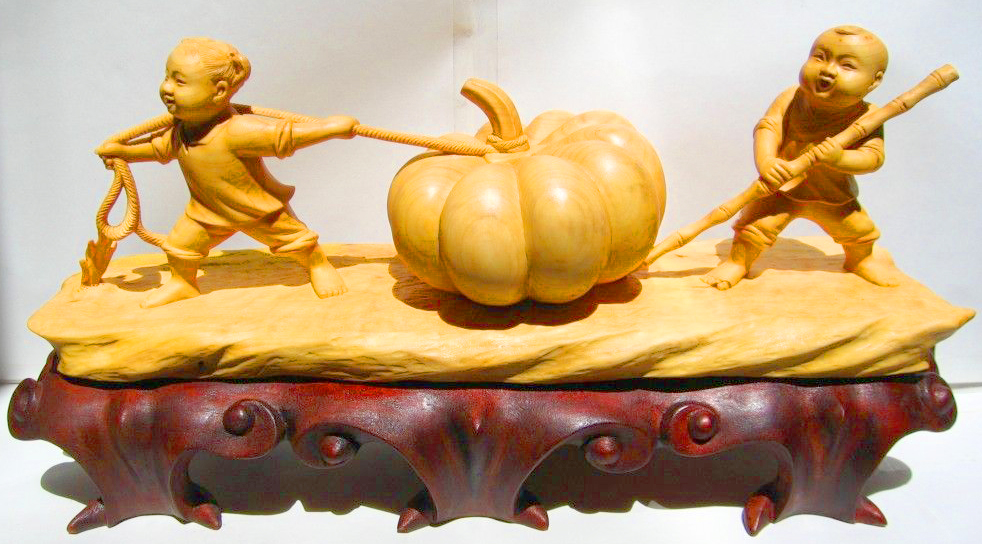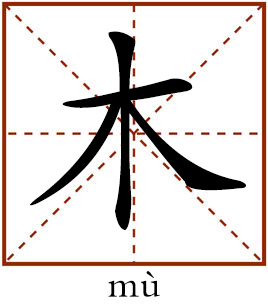Modern transformation of woodcarving

Modern woodcarving gradually becomes independent works of art, transforming its affiliated role in architecture and religious activities.

Mu (trees or wood) in Chinese language refers to all kinds of trees. Sharing the same component “木,” scores of Chinese characters mean either various kinds of trees, such as 松 (pine trees), 桦 (birches) and 枫 (maple trees), or wooded items such as 杖 (walking sticks) and 栏 (railings).
The development of woodcarving was closely related to the daily lives of people living in an agrarian age. These carvings showed mostly scenes of joy or sorrow. Reflections and thoughts on the society was another theme. Wood carvings used in traditional architecture reflected people’s needs in daily life—praying for good fortune, warding off evil spirits and educating young people in big families.
Immersed in the changing macroscopic culture and freely shaped by the folk society, woodcarving as an ornamental art expressed its cultural connotations by including themes based on metonymy, emblems and homophones.
For example, the image of peaches symbolizes “longevity” while the peony symbolizes “riches and honor.” Plants such as plum trees, orchids, bamboo and chrysanthemum symbolize the virtues of a virtuous person. Lotus flowers symbolize honesty and uprightness because they rise unsullied from mud.
Fu as in bianfu (bats) is the homophone of fu (blessings). Lu (deer) shares the same pronunciation as lu (emoluments of an government official). And the word for chicken or rooster is an homophone of the word for auspiciousness. The images in woodcarving works created in the folk society gradually evolved into symbols commonly accepted and integrated into people’s daily life and customs, becoming an important part of traditional Chinese culture.
Traditionally, woodcarving was connected with architecture, folklore and religious activities. However, the environment and thinking of modern life has drastically changed. The material and non-material foundations of traditional woodcarving are gradually dissolving.
In architecture today, buildings are built with steel or concrete. High buildings with metallic frames and glass curtain walls are also reducing the use of wood architecture. The limited availability of wood resources has pushed up the price of wooden materials while the number of new temples and ancestral halls being built has dropped in the process of urbanization. In terms of the woodcarvings used when offering sacrificing to ancestors, the falling demand for related goods as well as the increasing number of alternatives made with new materials and techniques also threaten the woodcarving industry.
The substantial changes that have taken place in the woodcarving sector are challenging the workers in this industry, who are struggling to maintain its vitality and sustainable development. In recent years, woodcarving artists have begun to explore innovation in this art while preserving it.
Two major changes have been made—changing the targeted groups of consumers that woodcarving is supposed to serve, and changing its original function. Traditionally, the woodcarving industry served wealthy and influential families, Buddhist temples and shrines of all kinds of gods. These people and organizations used to spend a great fortune purchasing precious woods and employing woodcarving artists. This is not the case today. However, new clients including art galleries, museums, exhibition halls, upscale hotels and villas have increasing demand for woodcarving works in their soft decoration.
In regard to its functions, traditional woodcarving was mostly used to decorate architecture, equipment in shrines or house furniture. However, woodcarvings have now gradually become independent ornaments or artistic works in their own right.
Zhao Liquan is from the College of Fine Art, Fujian Normal University. Zhang Ruizhi is from the School of Art, China Three Gorges University.
(edited by CHEN ALONG)
